#rapenburg
Explore tagged Tumblr posts
Text

Rapenburg, Amsterdam, at evening - Riek Wesseling ,ca. 1968-72.
Dutch, 1914-1995
black chalk , 83 x 117.5 cm.
154 notes
·
View notes
Text

Portrait of Dina Margareta de Bye
Artist: Willem van Mieris (Dutch, 1662-1747)
Date: 1705
Medium: Oil on panel
Collection: The Leiden Collection, New York City, NY, United States
Description
Standing before an imaginary rocky landscape, a woman handsomely attired in an orange-tinged brown satin dress with an aqua-blue shawl draped across her body smiles charmingly out at the viewer. On the left, behind a partially drawn curtain and in front of a pillar, stands a fountain with a statue of a cupid riding a sea monster. The woman holds an orange in her left hand and carefully selects a red carnation from a bunch of flowers lying on a stone plinth faced with a carved relief sculpture of an unidentified allegorical subject. Resting on this garden plinth is a colored drawing of a flower, a small wooden box, some paintbrushes, and a couple of shells containing pigments.
The identification of the sitter is established by an eighteenth-century inscription written in Dutch on the back of the panel: “Dina Margareta de Bye, born on 7 May 1680 and deceased on 26 August 1740.” Dina Margareta was the second daughter of Johan Paeuw de Bye, a lawyer from Leiden, and his wife, Anna van Oorthoorn. In 1703 Dina Margareta married Pieter van der Dussen (1675–1726), also a lawyer, and moved from Leiden, where she apparently had been living with her parents on the Rapenburg, to her husband’s native city of Dordrecht. As Willem van Mieris already enjoyed a great reputation among the Leiden elite, he was a suitable choice to portray the esteemed Dina Margareta, even after she had moved to Dordrecht.
#portrait#female#standing#three quarter length#dina margareta de bye#imaginary landscape#satin dress#aqua blue shawel#curtain#pillar#fountain#statue of cupid#orange#carnation#bunch of flowers#wooden box#paintbrushes#shells#painting#oil on anvas#fine art#willem van mieris#dutch painter#european art#18th century painting
5 notes
·
View notes
Text
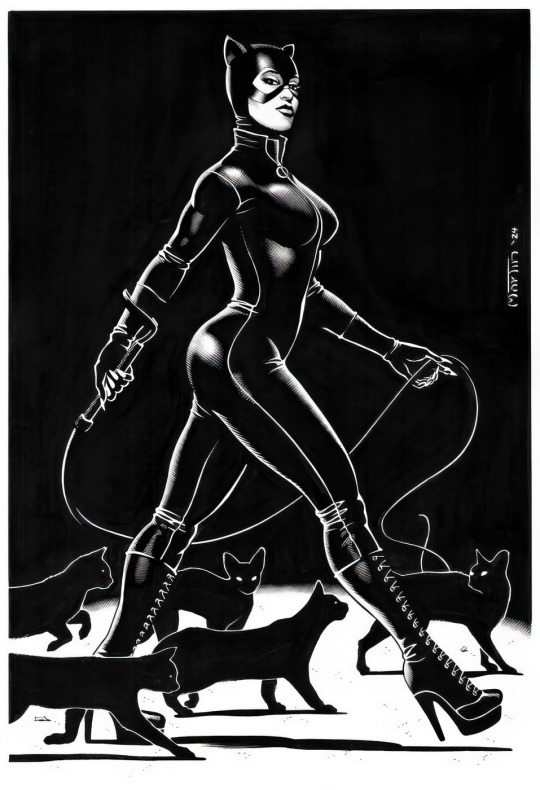



IMAGENES Y DATOS INTERESANTES DEL 12 DE ENERO DE 2025
Día Internacional de Besar a un Pelirrojo, Año Internacional de la Ciencia y la Tecnología Cuánticas.
Santa Tatiana, Santa Tania, San Benito Biscop y San Arcadio.
Tal día como hoy en el año 2010
En Haití, el país más pobre del continente americano, se produce un terrible terremoto de magnitud 7,3 grados en la escala Ritcher y con epicentro a unos 20 km de la capital, Puerto Príncipe, que queda reducida a escombros. El balance final de víctimas será de más de 250.000. De acuerdo a los registros históricos, Haití no sufría terremotos importantes desde hacia más de 200 años, los de mayor magnitud ocurrieron en 1751 y 1770 aunque nunca llegaron a alcanzar los 7 grados de la escala de Richter. (Hace 15 años)
1970
Con la rendición de Biafra, concluye la Guerra de Biafra iniciada el 6 de julio de 1967, poco después de que el comandante militar de Biafra, general Ojukwu, proclamara la secesión de la provincia oriental y el nacimiento de la república independiente de Biafra. La guerra ha sido muy costosa para Nigeria en términos de vidas humanas, dinero e imagen exterior. Se estima que alrededor de tres millones de personas han muerto durante las hostilidades, principalmente por hambre y enfermedades. Poco después del fin de la guerra, Yakubu Gowon decretará la amnistía y prometerá ceder el poder a un gobierno civil en 1976, pero en julio de 1975 un grupo de oficiales musulmanes, al mando del coronel Joseph Garba, jefe de la guardia personal de Gowon, lo derrocará y colocarán al frente del país al general Murtala Ramat Mohammed. (Hace 55 años)
1946
En esta fecha, el Consejo de Seguridad de Naciones Unidas se reúne por primera vez. En este momento, 51 estados forman parte de la ONU y el Consejo de Seguridad queda formado por 11 miembros. La membresía permanente del mencionado Consejo quedará en manos de los aliados victoriosos de la Segunda Guerra Mundial: Estados Unidos, la URSS, Francia, Reino Unido y China, siendo el resto miembros no permanentes y rotatorios. En virtud de una enmienda de fecha 17 de diciembre de 1963, que entrará en vigor el 31 de agosto de 1965, la Asamblea General aumentará el número de miembros no permanentes del Consejo de Seguridad de 6 a 10. Estos miembros no permanentes serán elegidos por la Asamblea General para un período de 2 años y no podrán ser reelegidos a la conclusión de su mandato. (Hace 79 años)
1933
Tienen lugar los llamados Sucesos de Casas Viejas, un alzamiento anarquista que encuentra una dura reacción por parte del gobierno de Azaña y de la Guardia Civil en Casas Viejas (Cádiz, España) al entrar ésta a tiros en el pueblo e incendiar la casa donde se han refugiado algunos de los dirigentes de la insurrección, entre ellos el conocido como "Seisdedos". A continuación se procede a una serie de juicios sumarísimos, y se fusila a los sospechosos de haber participado en los hechos. Serán catorce los asesinatos por los que, en mayo de 1934, el responsable directo, capitán Rojas, será enjuiciado y condenado a pena de 21 años de prisión, mientras que el director General de Seguridad del Estado, será absuelto. (Hace 92 años)
1816
En Francia, al considerar peligrosa a la familia de Napoleón, se aprueba una ley por la cual todos sus parientes deben abandonar el país. (Hace 209 años)
1807
La ciudad de Leiden (Holanda) resulta damnificada al estallar un barco que está cargando pólvora y amarrado ilegalmente en el lado Este del canal Rapenburg. La explosión, que destruye cientos de casas, siega la vida a unos 150 ciudadanos. El rey Luis Napoleón Bonaparte visitará personalmente la ciudad para coordinar la ayuda a las desgraciadas víctimas. (Hace 218 años)
1610
En Sevilla (España) se pregona públicamente el bando real de expulsión de los moriscos (musulmanes españoles bautizados tras la pragmática de los Reyes Católicos del 14 de febrero de 1502). La expulsión se realizará en condiciones brutales e incluso se producirán matanzas que llenarán de amragura y dolor a una minoría que será crítica con el odio, satisfacción e indiferencia del resto. (Hace 415 años)
0 notes
Text
Wat gebeurde er op 12 januari?
1807 – LEIDSE BUSKRUITRAMP
De ramp met het kruitschip vond plaats om kwart over vier ’s middags, ten tijde van de Franse bezetting. Een schip dat van Haarlem naar Delft ging had 37.000 Hollandse ponden (dat wil zeggen 17.760 kg) aan buskruit aan boord. Het ontplofte midden in Leiden in het Steenschuur in het verlengde van het Rapenburg. Bij de ramp vielen 151 doden en ruim 2.000 gewonden. Circa 220 woningen werden compleet verwoest of werden onbewoonbaar verklaard. Zelfs in de verste wijken in Leiden waren ramen kapot of werden dakpannen van het dak afgeblazen. Koning Lodewijk Napoleon was na vijf uur al op de plaats van de ramp; hij bleef hier ruim een dag. Hij wilde Leiden helpen en stelde duizenden soldaten aan om Leiden op te bouwen... Klik op de link hieronder voor meer Nieuws van Vroeger: http://johnooms.nl/2025/01/12/12-jan/
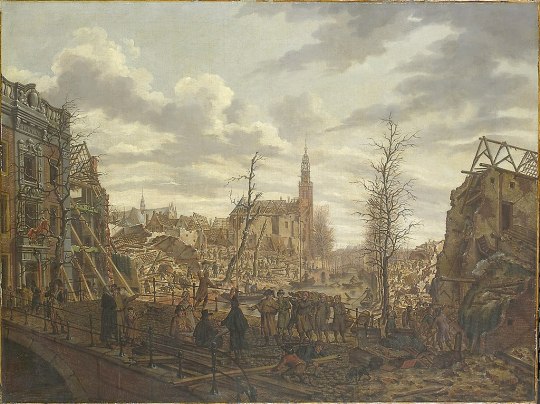
0 notes
Text
Gezicht op de Oosterkade met een woning en het Havenziekenhuis, 1946.
Rotterdam werd als havenstad niet alleen met zeelieden geconfronteerd, maar ook met de exotische ziektes die zij meebrachten. Het 19e-eeuwse Coolsingelziekenhuis had een aparte afdeling voor zieke zeelieden. In Leiden werd op 14 mei 1914 de 'Leidse Vereniging tot Bevordering van de Studie der Tropische Geneeskunde' opgericht. Bijna tien jaar later werd dat het 'Instituut voor tropische geneeskunde' dat gevestigd werd het herbarium aan het Rapenburg te Leiden. Omdat er in Leiden te weinig aanbod was van patiënten uit de tropen werden in 1925 de Havenpoliklinieken in Rotterdam geopend, die na korte tijd meer dan 2.500 zeelieden per jaar behandelen. Om praktische redenen werd daarom in 1927 het oude hotel Continental en het daarnaast gelegen huis aan de Oosterkade 22 en 24 en het parterregedeelte van nummer 26 omgebouwd tot 'Ziekenhuis voor Scheeps- en Tropische Ziekten', dat al snel het 'Havenziekenhuis' werd genoemd. Het ziekenhuis kreeg 75 bedden. In 1928 werd een badkamer op de eerste verdieping omgebouwd tot operatiekamer.
Al snel werd besloten tot nieuwbouw van het ziekenhuis op dezelfde locatie tussen het Haringvliet en de Maasboulevard. In december 1934 vertrokken personeel en patiënten naar een noodziekenhuis dat was ingericht in de voormalige kantoorpanden van Unilever aan de Westerlaan. In 1937 wordt het nieuwe ziekenhuis in gebruik genomen. De benaming ‘Ziekenhuis voor Scheeps- en Tropische Ziekten’ is nu officieel vervangen door ‘Havenziekenhuis’. Hoewel het Havenziekenhuis tijdens de Duitse aanval op Nederland in 1940 in de frontlinie lag, werd het niet getroffen. Ook tijdens het bombardement op Rotterdam werd het niet getroffen, alhoewel de brandgrens slechts op enkele tientallen meters was verwijderd. Tijdens de Tweede Wereldoorlog is de ontwikkeling van specialistisch ziekenhuis naar algemeen ziekenhuis ingezet: tijdens de oorlog waren er geen scheepvaartverbindingen met tropische gebieden en het algemene Coolsingelziekenhuis was verwoest.
De fotograaf is Gerard Roos en de foto komt uit het Stadsarchief Rotterdam. De informatie komt van Wikipedia.
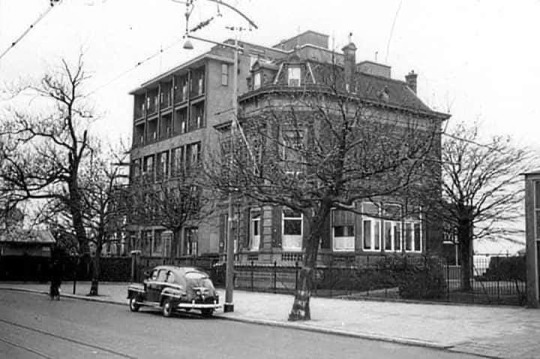
0 notes
Text
Nationale Jammarkt presenteert oudste koningin tot nu toe
De 32e Nationale Jammarkt is op woensdag 21 augustus van 10:00 tot 17:00 uur in Neede. De organisatie is er in geslaagd om veel nieuwe standhouders naar Neede te halen. Op het podium van de kruising Oudestraat, Borculoseweg, Rapenburg is om 11:00 uur precies de presentatie van de nieuwe Jamkoningin. “Ik kan nu al verklappen dat een koningin niet per se 18 hoeft te zijn”, vertelt de voorzitter.…
0 notes
Note
That would be the best! Can you rec me some things in Leiden (since you put a little <3), Utrecht, Maastricht and Breda for NL and Ghent if you have any
To do in Leiden:
- Visit the Burcht (a city park with 12th century remains of a castle fort and very nice view of the city and nearby church (Hooglandse kerk))
- Restaurant De Waag (very cool building on the in and outside)
- Walk through Rapenburg street, next to the canal. Is a nice walk with pretty houses
- Go to the Hortus Botanicus
- And the city center is very walkable and not too big so it’s easy to have a pretty walk (that’s why i love this city)
To do in Utrecht:
- Visit the Sint Martin’s Cathedral and the the pretty garden next to it (Pandhof van de Dom, it gives Harry Potter vibes)
- Dom tower
- Winkel van Sinkel Restaurant and Tapas Kelder (is in the same building)
- Miffy Museum lol
- Walk past the canal in the city center (Oudegracht, that’s also where you can shop great)
To do in Breda (i’ve never been there lol):
- Grote Kerk Breda (church)
- Beer Advertisement Museum (never been, looks fun tho)
- Walk through the city park Valkenberg
- Walk through city center , have a nice lunch somewhere
Maastricht (been there once like 5 year ago lol):
- Basilica of Our Lady (again an old church thing lol)
- Bookstore Dominicanen (is a bookstore in an old church, very cool)
- Market Square
To do in Ghent (been here once as well lol):
- Korenmarket
- Saint Michael’s Bridge
- Museum voor Schone Kunsten (art museum)
- Wasbar (a restaurant which is very slay with yummy food for breakfast and lunch)
- City hall Ghent
You should also go to Amsterdam but think that was a given so i didn’t say lol <3 but have a lot of tips for that as well if you ever wanna go
0 notes
Link
Prijs: 750 per maand Kamer omsch... #Kamer #Kamer #Leiden #ZuidHolland https://actuelekamers.nl/kamer-tehuur-leiden-contact-for-info-eur-10/?feed_id=57679&_unique_id=64f5bd448eb4d
0 notes
Text

Chimney with relief of Paris and Oenone, Jan Baptist Xavery, 1739
Leiden resident Diederik baron van Leyden commissioned the chimney for his home's grand hall at Rapenburg 48. It's likely that Xavery also sculpted the ceiling's decorative elements and fashioned the marble relief that can be seen above the doors. The room had a big artwork by Dutch master Jacob de Wit. Brussels tapestries decorated the walls. Together, they made quite a show.
Rijksmuseum.
On display in room 1.2
#dark academia#light academia#academia aesthetic#classical#academia#escapism#classic literature#books#books and libraries#architecture#interior#design#chimney#Jan Baptist Xavery#1700s#18th century#Rijksmuseum#royalcore#cottagecore#antique#aesthetic#historical#beautiful#craft#leiden#mood#vibe#academic#object
46 notes
·
View notes
Photo
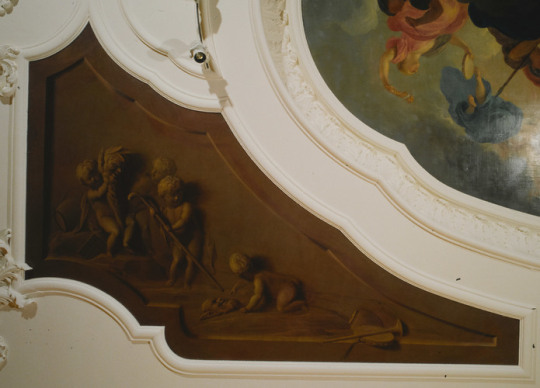
The Comedy, Jacob de Wit, 1743, Mauritshuis Museum
This ceiling painting comes from a house in Leiden (Rapenburg 48) and has been hanging here since 1912. Apollo, the classical god of the arts, is depicted on the oval centrepiece. He is surrounded by his nine muses, who stand for the various artistic disciplines. The four grisailles around the centrepiece represent the elegy, the comedy, the pastoral song and the epos. In the eighteenth century, the Amsterdam artist Jacob de Wit was the leading expert in this type of illusionist tour de force.
https://www.europeana.eu/portal/record/2021672/resource_document_mauritshuis_734.html?utm_source=api&utm_medium=api&utm_campaign=j4AoMQNzp
35 notes
·
View notes
Photo

Emmy Andriesse Children amid the rubble of Rapenburg in the Jewish Quarter. Amsterdam, spring 1945.
102 notes
·
View notes
Text
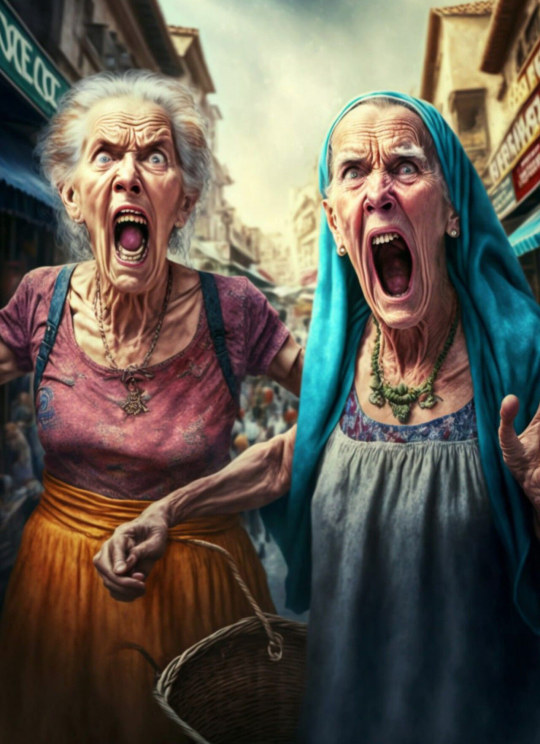



IMAGENES Y DATOS INTERESANTES DEL DIA 12 DE ENERO DE 2024
Día Internacional de Besar a un Pelirrojo, Año Internacional de los Camélidos.
Santa Tatiana, Santa Tania, San Benito Biscop y San Arcadio.
Tal día como hoy en el año 2010
En Haití, el país más pobre del continente americano, se produce un terrible terremoto de magnitud 7,3 grados en la escala Ritcher y con epicentro a unos 20 km de la capital, Puerto Príncipe, que queda reducida a escombros. El balance final de víctimas será de más de 250.000. De acuerdo a los registros históricos, Haití no sufría terremotos importantes desde hacia más de 200 años, los de mayor magnitud ocurrieron en 1751 y 1770 aunque nunca llegaron a alcanzar los 7 grados de la escala de Richter. (Hace 14 años)
1970
Con la rendición de Biafra, concluye la Guerra de Biafra iniciada el 6 de julio de 1967, poco después de que el comandante militar de Biafra, general Ojukwu, proclamara la secesión de la provincia oriental y el nacimiento de la república independiente de Biafra. La guerra ha sido muy costosa para Nigeria en términos de vidas humanas, dinero e imagen exterior. Se estima que alrededor de tres millones de personas han muerto durante las hostilidades, principalmente por hambre y enfermedades. Poco después del fin de la guerra, Yakubu Gowon decretará la amnistía y prometerá ceder el poder a un gobierno civil en 1976, pero en julio de 1975 un grupo de oficiales musulmanes, al mando del coronel Joseph Garba, jefe de la guardia personal de Gowon, lo derrocará y colocarán al frente del país al general Murtala Ramat Mohammed. (Hace 54 años)
1946
En esta fecha, el Consejo de Seguridad de Naciones Unidas se reúne por primera vez. En este momento, 51 estados forman parte de la ONU y el Consejo de Seguridad queda formado por 11 miembros. La membresía permanente del mencionado Consejo quedará en manos de los aliados victoriosos de la Segunda Guerra Mundial: Estados Unidos, la URSS, Francia, Reino Unido y China, siendo el resto miembros no permanentes y rotatorios. En virtud de una enmienda de fecha 17 de diciembre de 1963, que entrará en vigor el 31 de agosto de 1965, la Asamblea General aumentará el número de miembros no permanentes del Consejo de Seguridad de 6 a 10. Estos miembros no permanentes serán elegidos por la Asamblea General para un período de 2 años y no podrán ser reelegidos a la conclusión de su mandato. (Hace 78 años)
1933
Tienen lugar los llamados Sucesos de Casas Viejas, un alzamiento anarquista que encuentra una dura reacción por parte del gobierno de Azaña y de la Guardia Civil en Casas Viejas (Cádiz, España) al entrar ésta a tiros en el pueblo e incendiar la casa donde se han refugiado algunos de los dirigentes de la insurrección, entre ellos el conocido como "Seisdedos". A continuación se procede a una serie de juicios sumarísimos, y se fusila a los sospechosos de haber participado en los hechos. Serán catorce los asesinatos por los que, en mayo de 1934, el responsable directo, capitán Rojas, será enjuiciado y condenado a pena de 21 años de prisión, mientras que el director General de Seguridad del Estado, será absuelto. (Hace 91 años)
1816
En Francia, al considerar peligrosa a la familia de Napoleón, se aprueba una ley por la cual todos sus parientes deben abandonar el país. (Hace 208 años)
1807
La ciudad de Leiden (Holanda) resulta damnificada al estallar un barco que está cargando pólvora y amarrado ilegalmente en el lado Este del canal Rapenburg. La explosión, que destruye cientos de casas, siega la vida a unos 150 ciudadanos. El rey Luis Napoleón Bonaparte visitará personalmente la ciudad para coordinar la ayuda a las desgraciadas víctimas. (Hace 217 años)
1610
En Sevilla (España) se pregona públicamente el bando real de expulsión de los moriscos (musulmanes españoles bautizados tras la pragmática de los Reyes Católicos del 14 de febrero de 1502). La expulsión se realizará en condiciones brutales e incluso se producirán matanzas que llenarán de amragura y dolor a una minoría que será crítica con el odio, satisfacción e indiferencia del resto. (Hace 414 años)
0 notes
Photo

The Rapenburg, Leiden, three Days after the Explosion of a Powder Ship on 12 January 1807, Museum of the Netherlands
Gezicht op het Rapenburg te Leiden, drie dagen na de ontploffing van het kruitschip op 12 januari 1807. Op de brug op de voorgrond staan toeschouwers en soldaten, enkele mannen dragen een slachtoffer op een draagbaar weg. Rechts opgestapelde huisraad.
http://hdl.handle.net/10934/RM0001.COLLECT.8840
15 notes
·
View notes
Text
Uitbreiding van het Havenziekenhuis aan de Maasboulevard, juli 1965.
Rotterdam werd als havenstad niet alleen met zeelieden geconfronteerd, maar ook met de exotische ziektes die zij meebrachten. Het Coolsingelziekenhuis had een aparte afdeling voor zieke zeelieden. In Leiden werd op 14 mei 1914 de 'Leidse Vereniging tot Bevordering van de Studie der Tropische Geneeskunde' opgericht. Bijna tien jaar later werd dat het 'Instituut voor tropische geneeskunde' dat gevestigd werd bij het Rijksherbarium aan het Rapenburg te Leiden. Omdat er in Leiden te weinig aanbod was van patiënten uit de tropen werden in 1925 de Havenpoliklinieken in Rotterdam geopend, die na korte tijd meer dan 2.500 zeelieden per jaar behandelen. Om praktische redenen werd daarom in 1927 het oude hotel Continental en het daarnaast gelegen huis aan de Oosterkade 22 en 24 en het parterregedeelte van nummer 26 omgebouwd tot 'Ziekenhuis voor Scheeps- en Tropische Ziekten' dat al snel het 'Havenziekenhuis' werd genoemd. Het ziekenhuis kreeg 75 bedden. In 1928 werd een badkamer op de eerste verdieping omgebouwd tot operatiekamer.
Begin jaren 1930 werd besloten tot nieuwbouw van het ziekenhuis op dezelfde locatie tussen het Haringvliet en de Maas. In december 1934 vertrokken personeel en patiënten naar een noodziekenhuis dat was ingericht in voormalige kantoorpanden van Unilever aan de Westerlaan. In 1937 wordt het nieuwe ziekenhuis in gebruik genomen. Het ‘Ziekenhuis voor Scheeps- en Tropische Ziekten’ heette vanaf toen officieel 'Havenziekenhuis'. Hoewel het Havenziekenhuis tijdens de Duitse aanval op Nederland in 1940 in de frontlinie lag, werd het niet getroffen. Ook tijdens het bombardement op Rotterdam werd het niet getroffen, alhoewel de brandgrens slechts op enkele tientallen meters was verwijderd. Tijdens de Tweede Wereldoorlog is de ontwikkeling van specialistisch ziekenhuis naar algemeen ziekenhuis ingezet, er waren geen scheepvaartverbindingen met tropische gebieden en het algemene Coolsingelziekenhuis was verwoest.
In de periode 1961-1967 werd het Havenziekenhuis verbouwd en uitgebreid. De 'Vereniging voor Tropische Geneeskunde Rotterdam – Leiden' bood bij de heropening een kunstwerk aan van Francesco Somaini dat doet denken aan een uiteenspattende meteoriet. In 2005 werd het Havenziekenhuis een dochteronderneming van het Erasmus MC.
Vanwege structurele financiële problemen door hoge vaste lasten kwam de nieuwe eigenaar Erasmus MC tot de conclusie dat het Havenziekenhuis geen toekomst had. Ondanks een groeiend aantal patiënten leed het ziekenhuis verlies (in 2015 750.000 euro en in 2016 4.8 miljoen euro). Het Havenziekenhuis werd daarom gesloten en omgevormd tot een polikliniek met als aandachtsgebieden ouderengeneeskunde en tropen- en Infectieziekten.
De fotograaf is Ary Groeneveld en de foto komt uit het Stadsarchief Rotterdam. De informatie komt van Wikipedia.

0 notes

